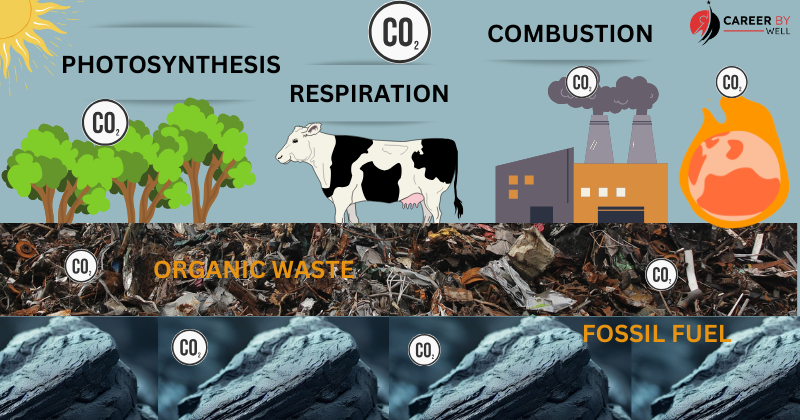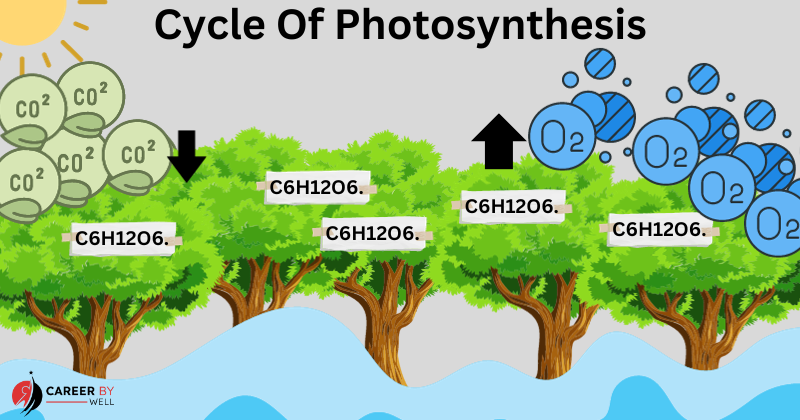The carbon cycle is a dynamic and interconnected system that maintains carbon balance in various reservoirs.
Generally, the complete movement of carbon from the atmosphere to the crust and again from the crust to the atmosphere is known as the carbon cycle. The carbon cycle is one of a biogeochemical cycle.
This describes the movement and exchange of carbon (in various forms) among the Earth’s atmosphere, oceans, terrestrial ecosystems, and the lithosphere (Earth’s crust).
Carbon is an essential element for life on Earth; it is a crucial cycle. Further, it plays a significant role in regulating the planet’s climate. Carbon is the main component of biological compounds and minerals such as limestone.
There are two stages of the carbon cycle.
- Carbon sequestration (storage)
- Carbon sinks (usage)
1. Carbon Sequestration
Carbon sequestration is a process by which carbon dioxide (CO2) is captured from the atmosphere or industrial sources and stored in various reservoirs to mitigate the buildup of CO2 in the atmosphere, contributing to global warming and climate change.
It aims to reduce the concentration of greenhouse gases in the atmosphere, particularly CO2, which is a major driver of climate change.
Some carbon is stored in the lithosphere as carbonate rocks, such as limestone. Over geological time scales, these rocks can release carbon through weathering processes and the dissolution of carbonates in water.
Carbon Release:
Some carbon is stored in soils as organic matter, which includes dead plant material, roots, and microbial biomass. This carbon can remain in the soil for extended periods, acting as a carbon reservoir.
Over geological time scales, carbon from ancient plants and marine organisms can become buried and subjected to heat and pressure. This process forms fossil fuels such as coal, oil, and natural gas, effectively sequestering carbon underground.
Carbon dioxide is released into the atmosphere through various natural and human activities. Natural sources include volcanic eruptions, wildfires, and the respiration of plants and animals.
Besides, Human activities, such as burning fossil fuels (coal, oil, natural gas), deforestation, and industrial processes, are significant contributors to atmospheric CO2.
Combustion:
When humans burn fossil fuels for energy, carbon stored underground is released into the atmosphere as carbon dioxide. This combustion process is a significant source of anthropogenic CO2 emissions, contributing to global warming and climate change.
Photosynthesis:
- Marine Photosynthesis: Phytoplankton and other marine plants conduct photosynthesis in the ocean, absorbing carbon dioxide and releasing oxygen. Zooplankton and marine animals, in turn, consume these photosynthetic organisms, transferring carbon through the marine food web.
- Terrestrial Photosynthesis: Green plants, algae, and photosynthetic bacteria in terrestrial and aquatic ecosystems absorb carbon dioxide from the atmosphere during photosynthesis. They convert CO2, sunlight, and water into glucose (sugar) and oxygen (O2).
Types of Carbon Sequestration:
- Terrestrial Carbon Sequestration: This involves capturing and storing carbon in terrestrial ecosystems, primarily through afforestation (planting trees on previously non-forested land), reforestation (replanting trees in deforested areas), and improved land management practices.
- Geological Carbon Sequestration: Also known as carbon capture and storage (CCS), this approach captures CO2 emissions from industrial processes, such as power plants, and injects it deep underground into geological formations, such as depleted oil and gas reservoirs or saline aquifers.
- Ocean Carbon Sequestration: This is a less commonly used method that involves capturing CO2 and injecting it into the deep ocean. However, it raises concerns about potential ecological impacts and is less widely implemented than terrestrial and geological methods.
2. Carbon Sink
A carbon sink is a natural or artificial reservoir or ecosystem that absorbs and stores more carbon dioxide (CO2) than it releases, helping to reduce the concentration of CO2 in the atmosphere.
Carbon sinks are critical in mitigating climate change by capturing and sequestering carbon, a major greenhouse gas responsible for global warming.
The world’s oceans act as a massive carbon sink. They absorb carbon dioxide from the atmosphere through physical and chemical processes. Dissolved CO2 forms carbonic acid, which can affect ocean pH and have implications for marine ecosystems.
There are two ways to carbon sinks.
- Natural Carbon Sinks
- Artificial Carbon Sinks
1. Natural Carbon Sinks:
- Forests: Forests are one of Earth’s most significant natural carbon sinks. Trees and other vegetation absorb CO2 from the atmosphere during photosynthesis, storing carbon in their biomass (trunks, branches, leaves) and the soil. This makes intact forests vital for carbon sequestration.
- Oceans: The world’s oceans are another major carbon sink. Oceanic phytoplankton and aquatic plants capture carbon through photosynthesis, while the oceans themselves can absorb dissolved CO2 from the atmosphere. This stored carbon can remain in the deep ocean for long periods.
- Wetlands: Wetlands, including marshes and swamps, store significant amounts of carbon in their soils. These ecosystems accumulate organic matter and sediment over time, effectively sequestering carbon.
- Grasslands: Grasslands, including prairies and savannas, also store carbon in their soils. The carbon is held in the roots of grasses and other plants and in the soil’s organic matter.
2. Artificial Carbon Sinks:
- Afforestation and Reforestation: Planting trees on previously non-forested land (afforestation) or replanting trees in deforested areas (reforestation) are deliberate efforts to create artificial carbon sinks. These projects help capture and store carbon in forests.
- Agricultural Practices: Some agricultural practices, such as agroforestry and conservation tillage, can enhance soil carbon sequestration, turning farmland into a carbon sink.
- Carbon Capture and Storage (CCS): CCS technology captures CO2 emissions from industrial processes, such as power plants, and stores it underground in geological formations, such as depleted oil reservoirs or saline aquifers.
Usually, Carbon sinks are a critical component of the global carbon cycle, helping to regulate the Earth’s climate by absorbing and storing carbon. Their conservation and responsible management are vital strategies for addressing the challenges posed by rising atmospheric CO2 levels and climate change.
Importance of Carbon Cycle
The carbon cycle is paramount to the functioning of Earth’s ecosystems, regulating the planet’s climate, and sustaining life on Earth. It describes the continuous movement and exchange of carbon between the atmosphere, oceans, terrestrial ecosystems, and the Earth’s crust.
Regulation of Earth’s Climate:
The carbon cycle plays a fundamental role in regulating Earth’s climate. Carbon dioxide (CO2) is a greenhouse gas that traps heat in the atmosphere, contributing to the greenhouse effect.
The balance of carbon in the atmosphere affects global temperatures. Understanding the carbon cycle is essential for climate modelling and addressing climate change.
Photosynthesis and Respiration:
The carbon cycle is intimately tied to photosynthesis and respiration, two fundamental processes in all living organisms.
Photosynthesis involves the uptake of CO2 by plants, algae, and photosynthetic bacteria to produce organic compounds and oxygen.
Respiration, on the other hand, releases CO2 back into the atmosphere when organisms, including plants, animals, and microorganisms, use organic compounds for energy.
Energy Flow:
The carbon cycle is closely linked to the flow of energy through ecosystems.
Photosynthesis captures solar energy and converts it into chemical energy stored in carbon compounds, transferring energy through food chains and webs as organisms consume one another.
Food Production:
Agriculture depends on the carbon cycle. Plants take up CO2 from the atmosphere to produce crops, which provide food for humans and animals.
Understanding carbon cycling in agricultural systems is critical for sustainable food production.
Carbon Storage:
The carbon cycle involves the storage of carbon in various reservoirs, including living organisms, soils, and fossil fuels.
Carbon sequestration in forests, wetlands, and oceans helps regulate the concentration of CO2 in the atmosphere and mitigate climate change.
Buffer Against Climate Change:
Natural carbon sinks, such as forests, act as buffers against climate change by capturing and storing CO2.
Conserving and restoring these sinks are important strategies for mitigating the impacts of rising atmospheric CO2 levels.
Carbon as a Nutrient:
Carbon is a vital nutrient for all life forms. It forms the structural basis of organic molecules, including proteins, nucleic acids, carbohydrates, and lipids, which are essential for the growth and functioning of organisms.
Ocean Health:
The oceanic carbon cycle influences ocean chemistry and acidity. It plays a role in forming calcium carbonate shells and skeletons by marine organisms, such as corals and shellfish.
Changes in oceanic carbon cycling can impact marine ecosystems and biodiversity.
Long-Term Carbon Storage:
Geological processes associated with the carbon cycle contribute to the long-term storage of carbon in the Earth’s crust.
This includes the formation of fossil fuels like coal, oil, and natural gas, which have been critical for human energy use but also contribute to carbon emissions when burned.
Scientific Understanding:
Understanding the carbon cycle is essential for scientific research and climate modelling. It provides insights into past climate changes, helps predict future climate trends, and guides efforts to mitigate climate change.
In short, the carbon cycle is a foundational Earth system process that affects climate, energy flow, food production, and the health of ecosystems. Its balanced functioning is critical for sustaining life on Earth and addressing the challenges of climate change.
Final Thoughts
The carbon cycle is a dynamic and interconnected system that maintains carbon balance in various reservoirs.
Understanding this cycle is essential for addressing global climate change, as the accumulation of carbon dioxide in the atmosphere is a primary driver of rising global temperatures and associated environmental impacts.

